This story is the continuation of Part I. Today’s post, told in story form, is one part factual and 2-3 parts very liberal interpretation. (All names have been changed to protect privacy.)
James
There once was a man named James. He was a highly successful businessman. He was very interested in education but deeply disappointed by the lack of apprenticeships available to other young and aspiring businessmen like himself. To offset this scarcity, James, along with his brother and brother-in-law, decided to start a business college. Much to their joy, the new college took off like gangbusters. Soon James was helping businessmen and women achieve their career goals. (The ladies department opened in 1855 thanks to Lucy Stone.)
Life in the city was a grind. Work was energizing, but James and his family needed a place to recharge their batteries, so he bought a large parcel of pastoral land two hours south of the big city. He had a beautiful traditional Victorian built on the land. It was exactly what he wanted. Life was good.
James’s Daughter
James and his wife Harriet had one daughter named Winnie. She was their pride and joy. Winnie was growing up fast, and James and his wife wanted to keep her close but offer her some independence when she reached adulthood.
James called his architect, and their conversation went something like this:
James: I want to build a grand house for my daughter. It must be large enough to entertain her girlfriends and all potential suitors. Spare no expense. She is our treasure, and she deserves the best.
Architect: Shall I design a Victorian that matches yours?
James: Definitely not. Let’s go an entirely different direction with this one. I am going to let you figure out all of the specifics, but by all means, get weird. Make is special just like my darling Winnie.
The architect’s eyes gleamed. He had so many ideas floating around in his head. After building a ton of Victorians, he could not wait to create a masterpiece all of his own. That very morning he had thought to himself, If I have to draw one more turret, I think I will scream.
Winnie’s Summer House
At his drafting table, the architect furiously drew out plans. His creativity flowed like mountain snow melt. He began with the basic Colonial style. To create an informal feel, he drew shingle siding in place of wood clapboard. Freed from the bonds of tradition and inspired by the centennial, he added a delivery porch and a covered entry. The pièce de résistance was an enormous wraparound porch. He sat back to admire his beautiful Colonial Revival meets Shingle Style masterpiece. He had created something entirely new. It was vast and stately from the street, and it was well-suited for social gatherings indoors. In other words, it was business in the front, party in the back. He had created the ultimate architectural… skullet.
The Interior
Once he finished drawing the exterior, the architect began working on the interior. He designed a foyer where Winnie and her girlfriends would make a grand entrance as they descended the staircase.
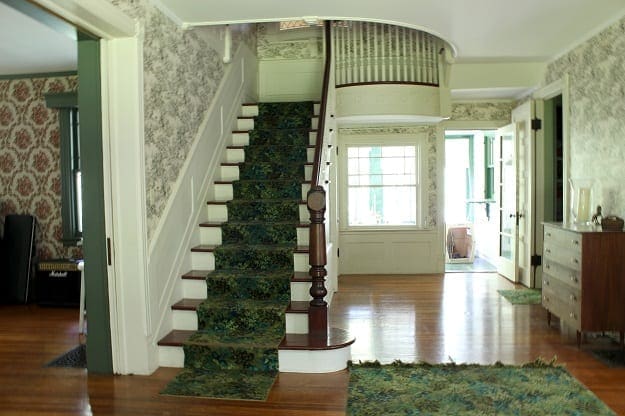
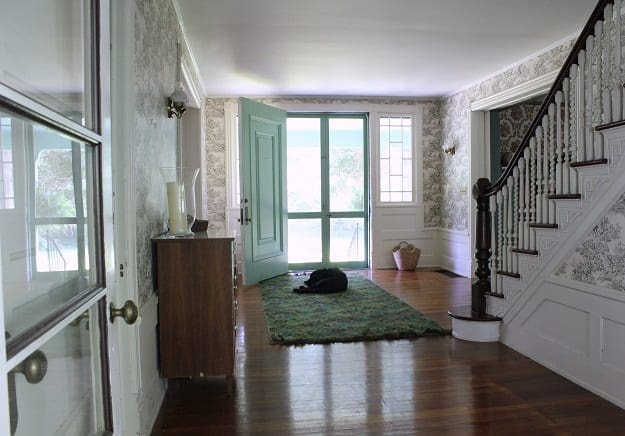
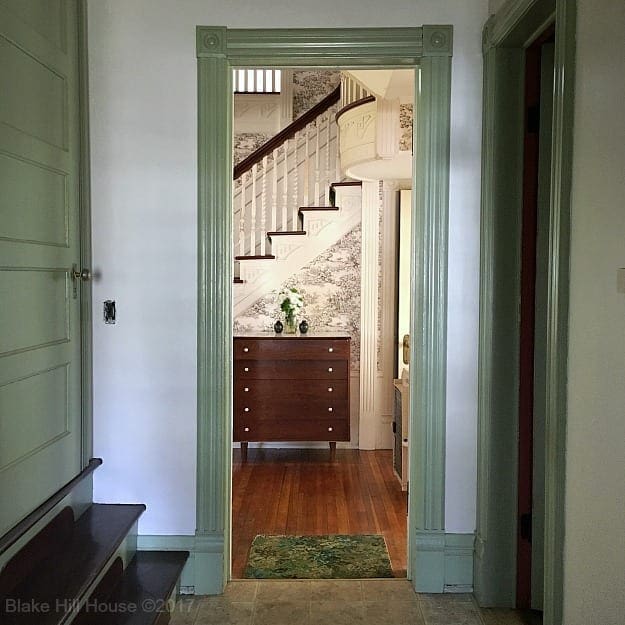
Just like a traditional Colonial, the architect drew the dining room on the right and the living room on the left. By this time, he was feeling very pleased with his project.
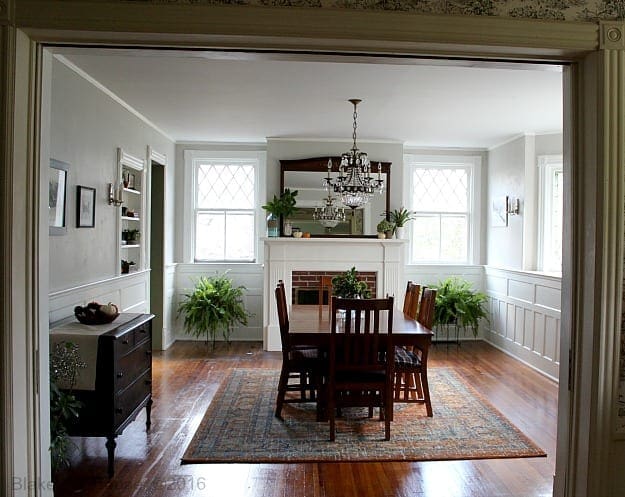
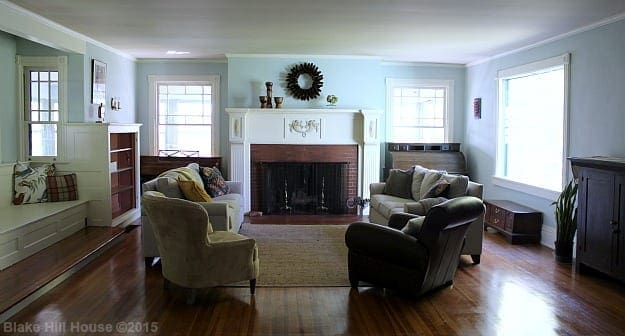
More Victorian, Please.
About halfway through the design process, the architect and Harriet sat down for a meeting where they had the following conversation:
Harriet: I appreciate all of your hard work, but I am just not feeling this design. How shall I say this? It’s a little too Colonial.
Architect: (slightly indignant) It is not Colonial, it’s Colonial Revival! (Muttering under his breath: Honestly! It is so much more than that.)
Harriet: I never thought I would say this, but could we make it a little more Victorian?
Architect: (Deep sigh) Of course, ma’am. What is your vision?
Harriet got right to work expressing her wishes. The builders added a beautiful leaded glass window on the landing.
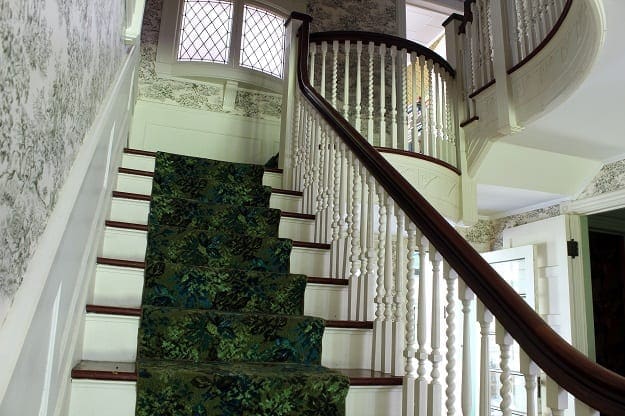
The plain window in the dining room was replaced with a leaded glass bay window and sideboard.
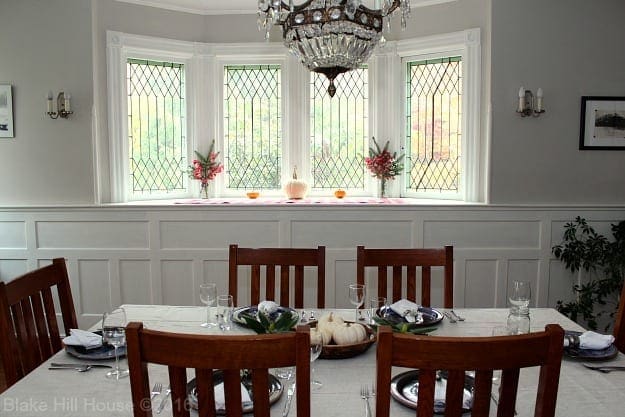
Also in the dining room, Harriet asked for the fanciest chandelier available. It was not as gorgeous as her daughter Winnie, but it was close.
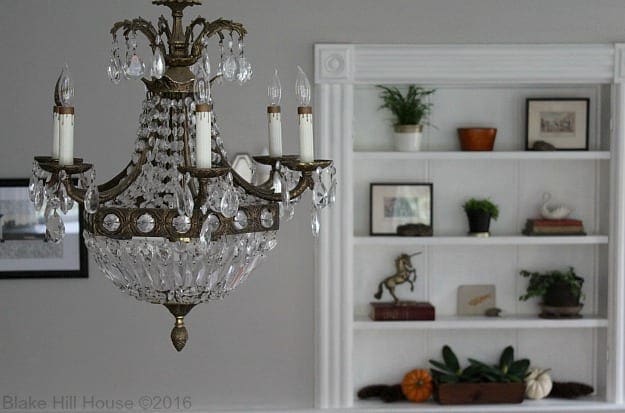
The architect had already designed the living room to be large enough for dancing and merriment. What it lacked was seating. Everyone knew that the eligible women far outnumbered the suitable men at any party. Winnie and her friends needed a place to demurely sit while they awaited their chance to dance with potential suitors.
After a bit of thought, the architect and the builder came up with this dance bench.
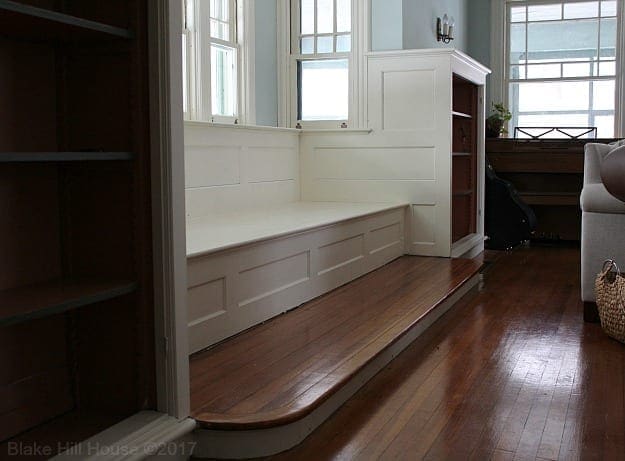
The house was coming together beautifully.
The Final Details
Around all of the doors and windows, the builders went back to the basics of the Victorian style and added rosettes, fancy casings, and tall plinth blocks.
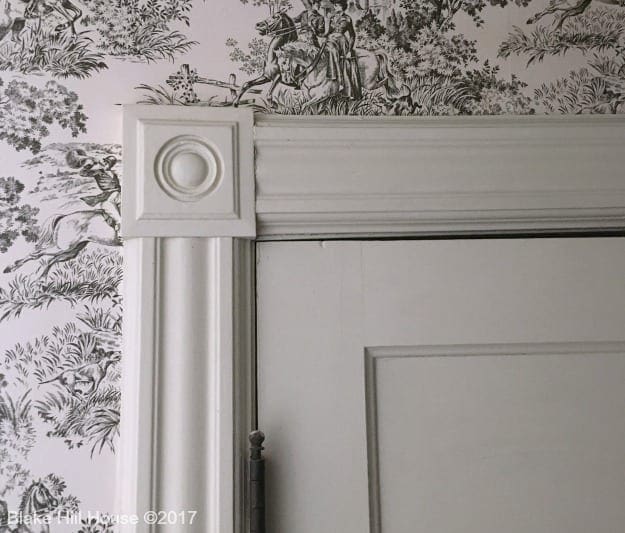
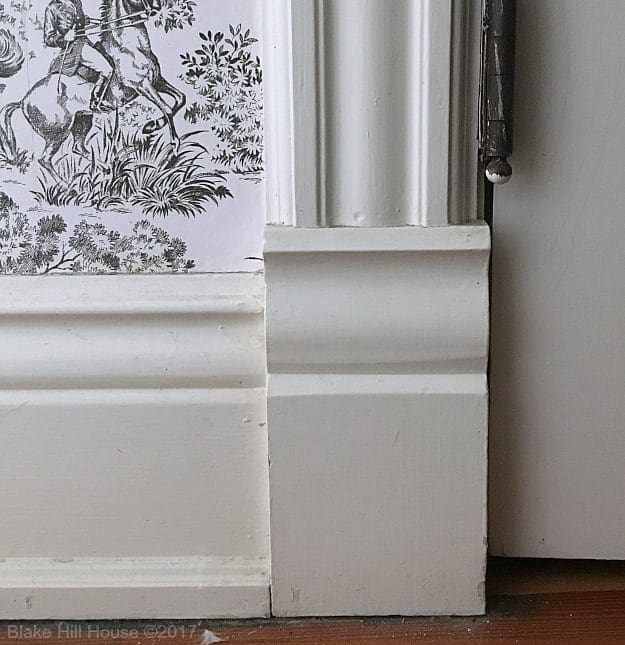
Honing in on the details, the builders adorned the doors with fancy knobs, and throughout the house, they embellished the doors, windows, and cabinetry with Eastlake hardware.

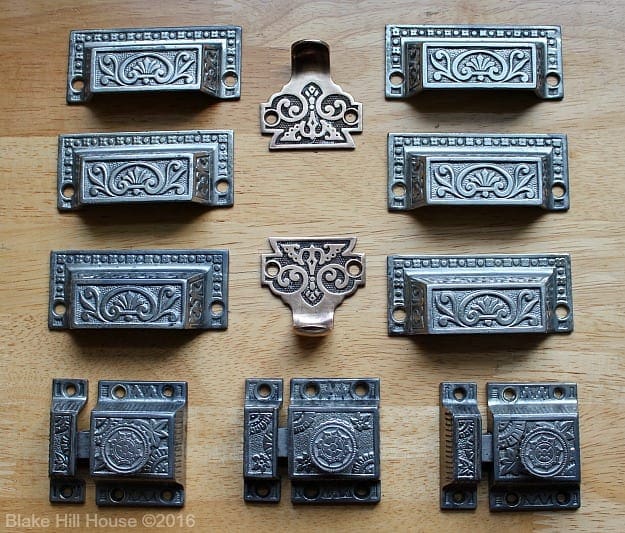
A home this grand took a very long time to build. After many months, it was ready, and James and Harriet presented it to their newly adult daughter, Winnie. Of course, she was delighted. That summer, James and Harriet arranged a giant party to show off Winnie’s house and have some fun.
All of the party guests loved the house. They ooohed over the ornate staircase. They ahhed about the ingenious dance bench. Music played, and the wine flowed. Winnie must have looked particularly fetching in her bustle because that very night she met Phillip, and, oh my gosh, he was the one.
Phillip and Winnie became inseparable in that chaste way that two people who are not allowed to touch each other before marriage do. During their courtship, Winnie’s parents, James and Harriet, were faced with some difficult news. Phillip was moving to Virginia, and after the wedding, Winnie would move to Virginia too. The fun times at Winnie’s new summer house were over almost before they started.
Shortly after the wedding, James sold Winnie’s house, and he walked over to the house to take one last look. James walked from room to room admiring the craftsmanship and thinking about how much he would miss Winnie. As he was descending the staircase and running his hand gently across the smooth banister, he thought to himself; This work of art will stand forever. Someday, someone should pull out a quill pen and write a diary about this grand house. People all over the world will want to hear its story.
He took one last glance into the dining room and living room. Then he walked out onto the wraparound porch and pulled the large, heavy door closed behind him. It was the end of one chapter and the beginning of another.
***
James, Harriet, and Winnie’s story is based on the historical data that we received when we purchased BHH. The very next chapter, which I know almost nothing about at this time, begins with a banker. Remember this picture?
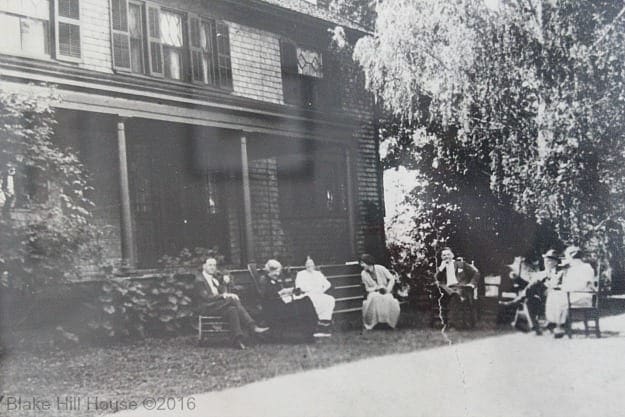
Yep, that’s him, looking directly at the camera.
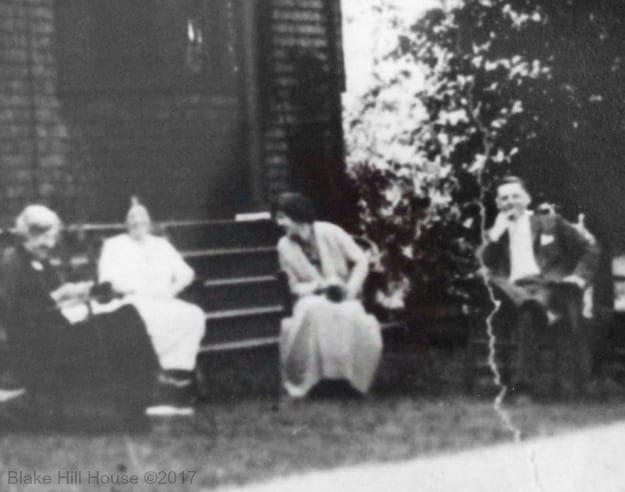
There is no Part III, so for now, we will all have to make up our own stories about the banker and his family.
***
We received some fantastic and informative comments on yesterday’s post. If you have not seen the comments, please do go back and take a look. Devyn’s comment is particularly thought-provoking. Before I read it, I felt pretty confident about sticking the label of Colonial Revival with Victorian leanings on BHH. Now, I am not so sure. In the end, I suppose it does not even matter.
What do you think?



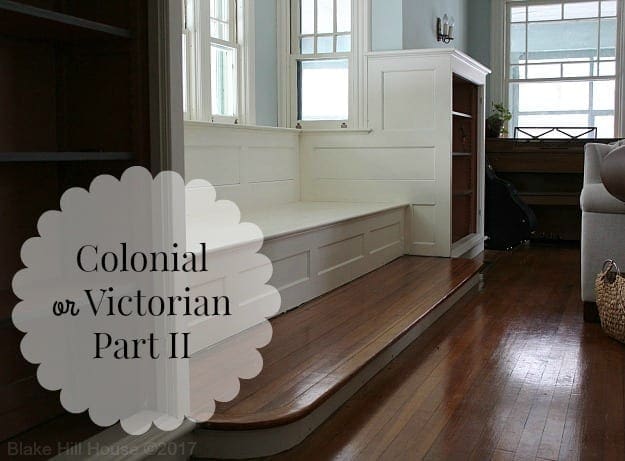
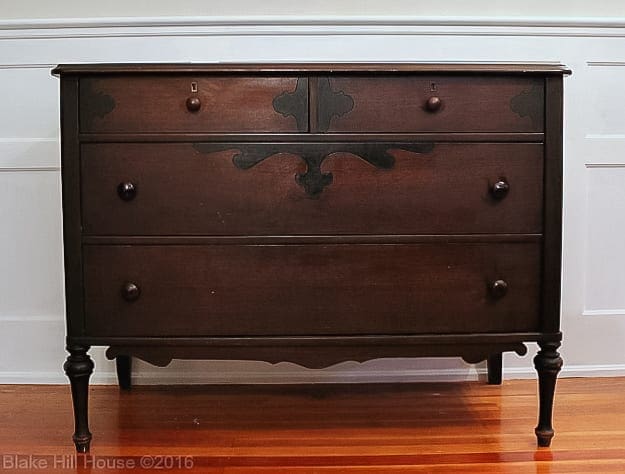
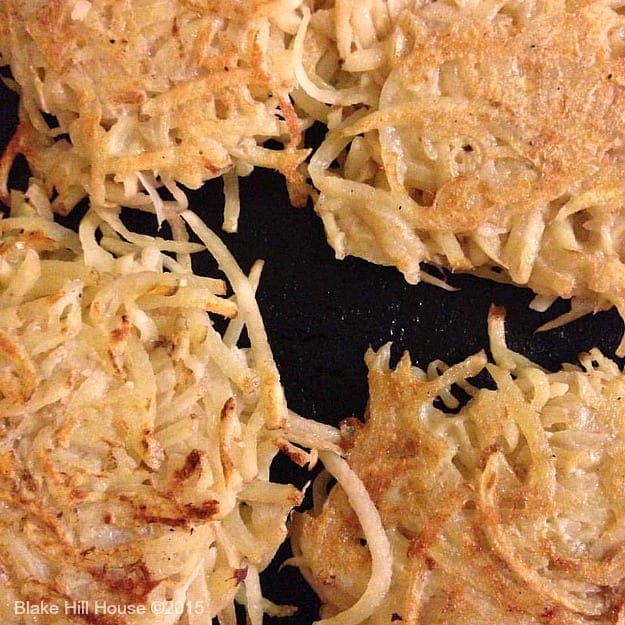
9 Comments
Andrea Matters
I’ve been checking back all day for Part II! Thanks so much for an entertaining read about your fabulous house!
Stacy
Thanks for reading it. 🙂 It took much longer to write than I thought it would.
Devyn
Garsh, I’ll admit to fact checking a few of my comments before posting, but much of what I said is based on my long standing (30+ years) curiosity of how American housing transitioned from that of being basic shelter to the houses of the 20th century. A time when standards rose at an unprecedented pace. In 1850, few houses had indoor plumbing, but within a few short decades that became standard. As did the shift from whale oil lamps, to gasoliers, to electricity. Then there is the advent of heating and ventilation systems. Barns made way for carriage houses which made way for garages. It is a fascinating time in the history of housing. By 1925, the vast majority of what we expect should be in a house had been established as the norm (air conditioning not withstanding).
BHH is smack in the middle if it, and this was a very exciting time in housing history. Your house hearkens to that of a more genteel class of people and not a building based on the fads of the day. A well do do family had a lot of fancy amenities for the time (which we take for granted today). I see a mostly Victorian interior with Colonial stylings. The center hall is a very Colonial layout. The fabulous staircase has an exuberance that is toned down just a bit. It screams Victorian in the massing and scale, but it has Colonial elements. (a true Colonial staircase would have been much less ornate). The bow window on the landing is to die for, and I love the bowed rail at the landing as well.
The beauty of this mix is that you get a lot of the bells and whistles of the Victorian era (and delightful quirkiness) which are toned down by the Colonial influences. The interior likely didn’t ever have any of the then popular Victorian Gingerbread trim, but instead the layout was rather stately and elegant, with a somewhat formal feeling. That said, it is still quite Victorian in many of the interior details.
It is a beautiful house and you are quite fortunate to have much of the original detail, even if many parts are buried under layers and layers of paint. I very much enjoy that you love BHH and have come to appreciate it for what it is.
Stacy
Devyn, I cannot thank you enough for weighing in on both posts. Everything you have written is so engaging, informative, and thought-provoking. You have clearly done your research, and I appreciate that you took the time to post these comments.
The original Victorian is just a stone’s throw from BHH. Also, the banker built a third very large home just up the street from BHH. It is also a Colonial Revival meets Shingle Style masterpiece. 🙂 Of the three houses, BHH is the smallest and plainest if you can believe that! If you and Yoav ever make your way up here, I will take you on a fascinating tour. Our town looks like a snow globe village.
Devyn Caldwell
Thanks for the kind words. I have been an old house person from the time we visited family friends in a gigantic old Victorian in central California as a child. I was in love with how little it resembled our 1970s tract house.
Yoav and I are looking forward to weekend excursions in our future. 🙂
Kelly
This is so interesting! I didn’t realize that was a dance bench with a step up – so cool! Have you ever shown pictures of the original carriage house? Is it still standing?
Stacy
🙂 I have not shown pictures of the carriage house. It belongs to my neighbor now. It was included with the parcel of land that he bought in the 1970s. One of these days, I will ask him if I can photograph it and share the pictures on the blog.
Christine
“but by all means, get weird.” Ha! I love this post 🙂
Your house has a very interesting history, especially the fact that it didn’t stay with its original family very long at all. I do have to say, I am very jealous of your house’s hardware. We have some original knobs on the doors, but the windows were replaced with wood replacements sometime in the last 15 years or so, and our doors don’t have very exciting hinges. A couple of the original windows were salvaged to make cupboard doors in our butler’s pantry area of the kitchen, so at least the previous owners thought to salvage some things.
Stacy
😀 I am glad that you liked the post.
It is hard to believe that this house was barely finished before it changed hands. We are very appreciative of all of the original hardware. I do have to wonder if some of it was sold or switched over time. In particular, I am curious why we have basic brass window pulls and latches and fancy Eastlake hardware in all of the areas that would have been used mostly by the house staff. It could have been a matter of taste, availability, or the hardware might have been changed at some point. It is all one big mystery.